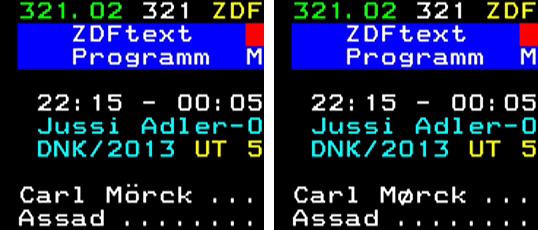 | ||
World System Teletext (or WST) is the name of a standard for encoding and displaying teletext information, which is used as the standard for teletext throughout Europe today.
Contents
Development
It originally stems from the UK standard developed by the BBC and the UK Independent Broadcasting Authority in 1974 for teletext transmission, extended in 1976 as the Broadcast Teletext Specification. With some tweaks to allow for alternative national character sets, and adaptations to the NTSC 525-line system as necessary, this was then promoted internationally as "World System Teletext". It was accepted by CCIR in 1986 under international standard CCIR 653 (now ITU-R BT.653) as one of four recognised standards for teletext worldwide, and may now most commonly be referred to as CCIR Teletext System B.
Almost all television sets sold in Europe since the early ’80s have built-in WST-standard teletext decoders as a feature.
WST is used for all teletext services in Europe & Scandinavia, including Ceefax from the BBC and services from Teletext on ITV in the United Kingdom, ZDFtext from ZDF and ARDText from ARD in Germany, and Tekst-TV from NRK in Norway, among many other teletext services offered by other television networks throughout the European continent.
Levels
In the early 1980s a number of higher extension levels were envisaged for the specification, based on ideas then being promoted for worldwide videotex standards (telephone dial-up services offering a similar mix of text and graphics). The proposed higher content levels included geometrically-specified graphics (Level 4), and higher-resolution photographic-type images (Level 5), to be conveyed using the same underlying mechanism at the transport layer. No TV sets currently implement the two most sophisticated levels.
Level 1 (1976)
The initial specifications set out by the BBC, IBA, BREMA in September 1976:
Level 1.5 (1981)
An extended version of level 1, with support for 13 extended character sets and other ASCII-like characters.
Level 2 (1988)
New features:
(Level 2 was replaced by level 2.5)
Level 2.5 teletext / Hi-Text (1995)
A new graphic standard found its way to the European market around 2000: Level 2.5 or HiText. With Level 2.5 it is possible to set a background colour and have higher resolution text and images. However, very few television stations transmit their teletext in this new standard. One of the problems with Level 2.5 is that it often takes several transmission cycles before the higher resolution items show on the screen. In order to watch Level 2.5 teletext, a rather recent television set with a special decoder chip is required.
New features:
The system has not been widely implemented, with only a handful of European state broadcasters supporting it. Television stations which are known to transmit teletext in Level 2.5 include:
Level 3
New features:
(Level 3 was replaced by level 3.5)
Level 3.5 (1997)
Extends the number of re-definable characters and their complexity and introduces different font styles and proportional spacing.
New features:
Level 4 (1981)
Tested by IBA
Level 5
Full-definition still pictures allows better quality than video cameras
WST in the United States
WST also saw some use in the United States in the 1980s, for the Electra service, which was carried on SuperStation WTBS (now TBS). It was also used for other teletext services on other television stations and networks in the USA as well.
Zenith in the US also included built-in WST teletext decoders in their higher-end models of TV sets, such as their Digital System 3 line throughout the 1980s. Also, Dick Smith Electronics offered through their American distributors a WST teletext decoder in the form of a set-top box, which was sold as a kit.
This was all in competition to another teletext standard developed exclusively in North America, NABTS (North American Broadcast Teletext Standard). It was developed in Canada by Norpak, and was used by CBS for their ExtraVision service and for a very short time by NBC in the mid-1980s. However, NABTS never became as successful as WST in the American continent, since NABTS was a more advanced technology, which required a much more complicated and expensive decoder (even though it had improved graphics capability over WST).
